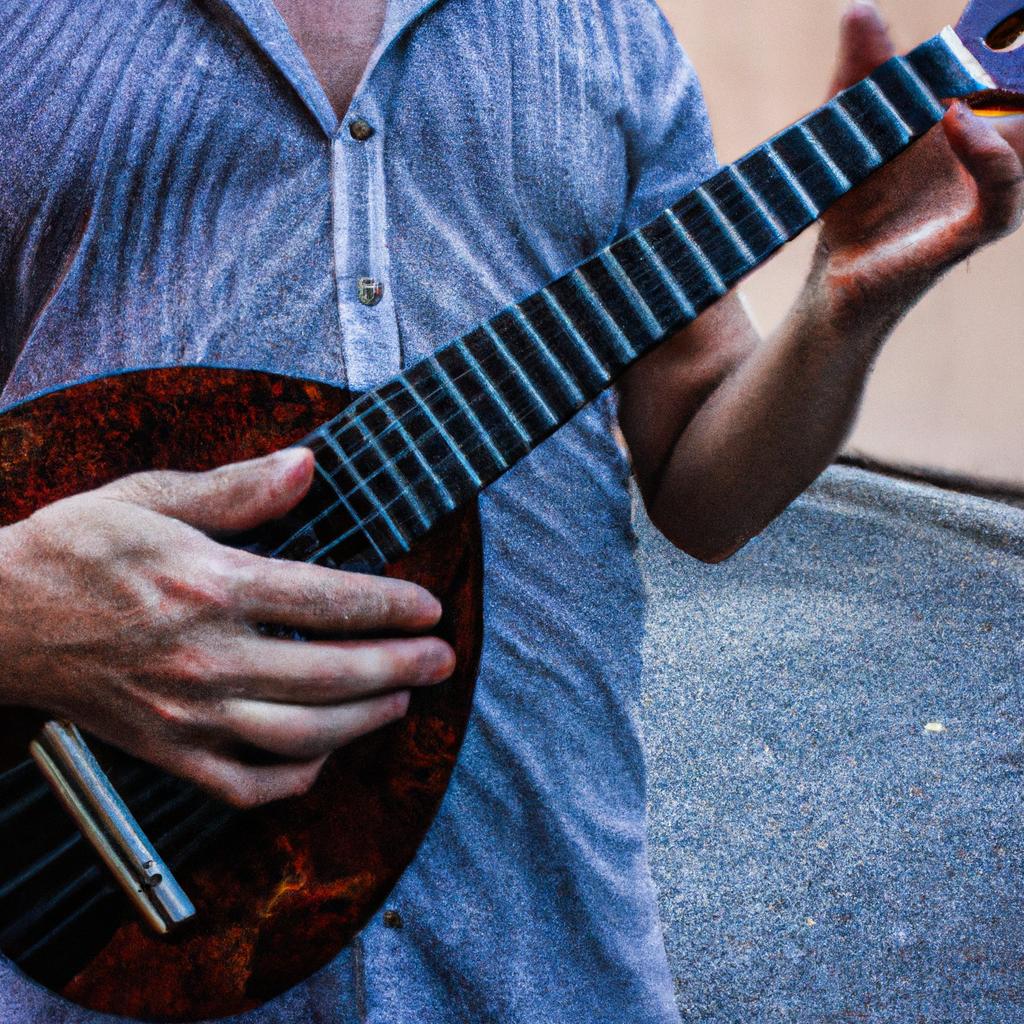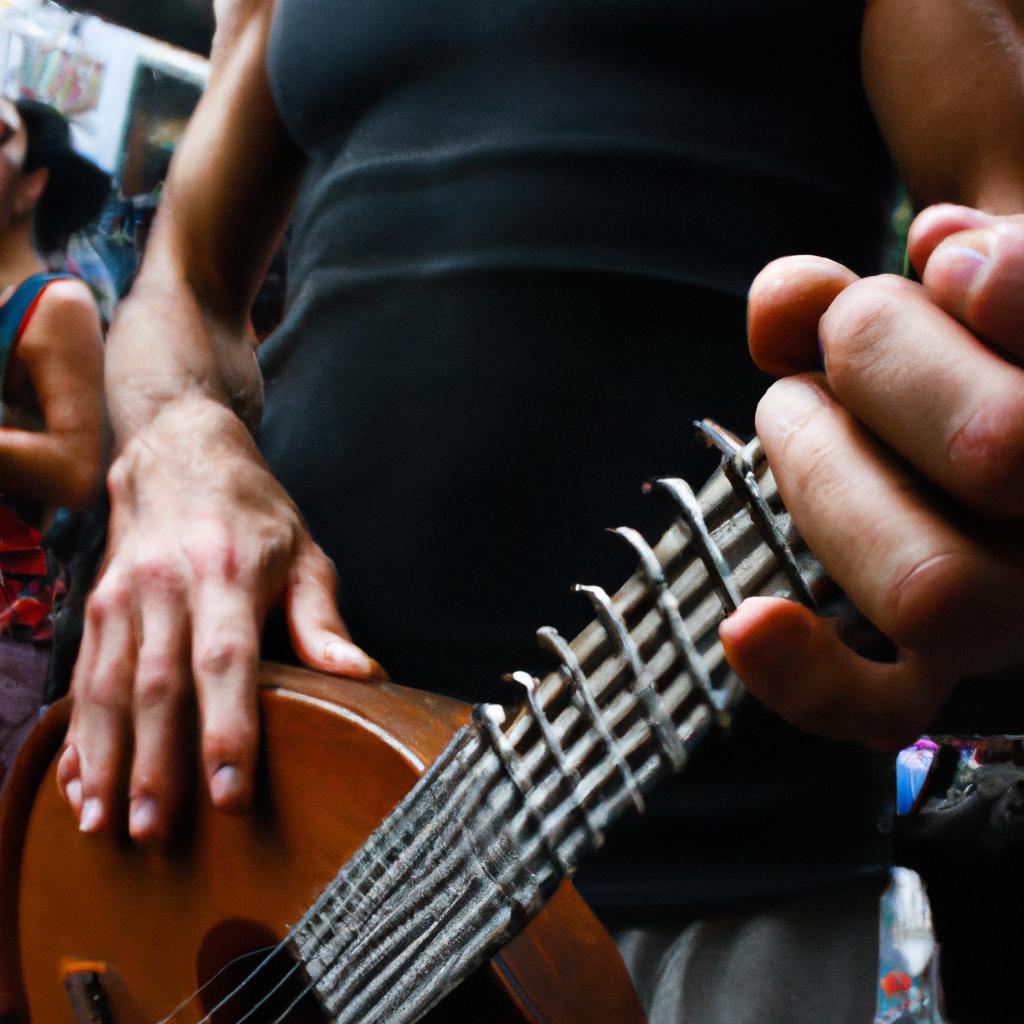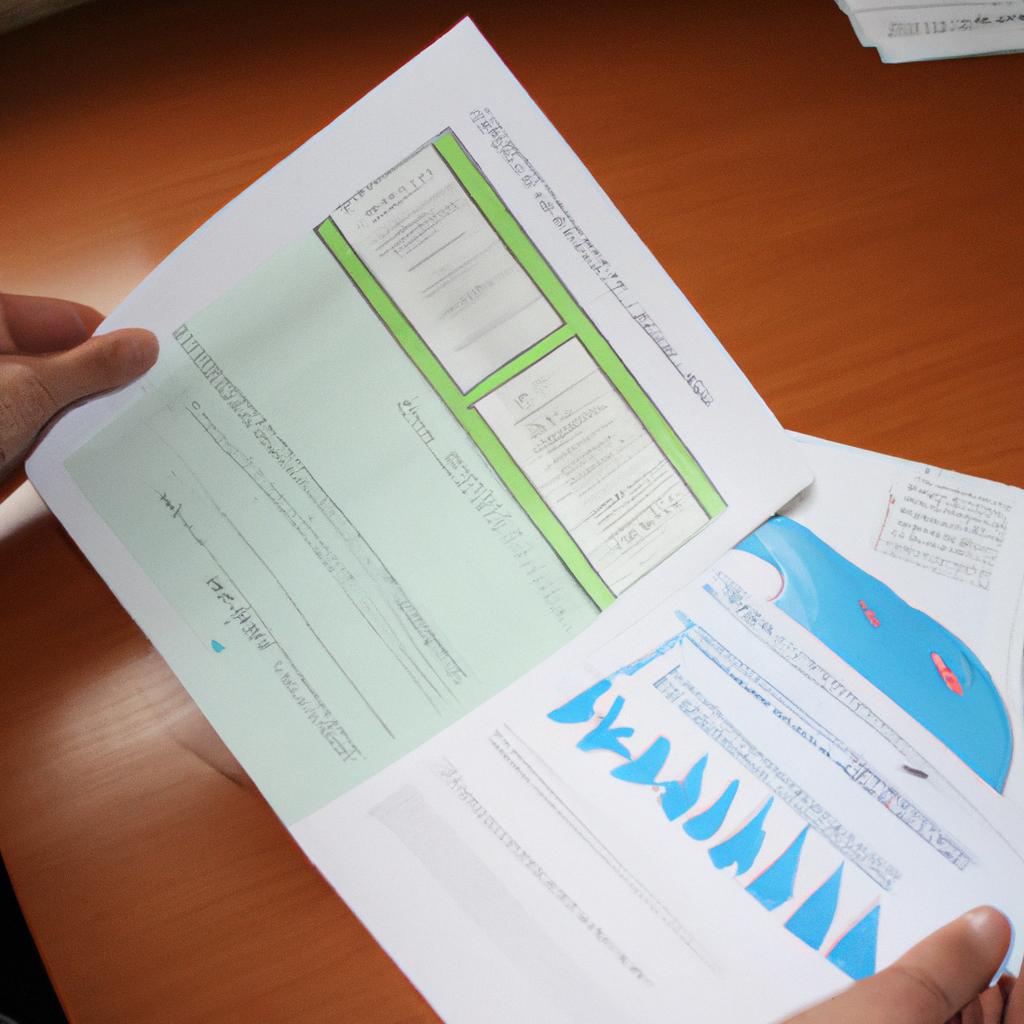Tango, a passionate and rhythmic dance originating from the streets of Buenos Aires, has captivated audiences worldwide with its expressive melodies and intricate footwork. Beyond its cultural significance, tango also presents intriguing investment opportunities through the world of tango instruments. For instance, consider the case of Maria, an astute investor who recognized the potential in investing in bandoneons – a key instrument used in tango music. By purchasing rare vintage bandoneons at relatively low prices and reselling them to collectors and musicians alike, Maria was able to generate substantial profits over a short period.
Investing in tango instruments such as bandoneons can be an alluring prospect for those seeking unique ventures within the realm of alternative investments. As traditional financial markets become increasingly saturated and volatile, individuals are turning towards unconventional avenues that offer diversification and potentially higher returns. Tango financing provides an avenue for investors to delve into a niche market while simultaneously contributing to the preservation of this rich musical heritage.
This article aims to explore various investment opportunities within the realm of tango financing, focusing on lucrative investments in tango instruments like bandoneons. Through an examination of historical trends, current market dynamics, and success stories from seasoned investors like Maria, readers will gain insights into how to navigate the tango instrument investment landscape and potentially capitalize on this niche market.
Historical trends in tango instrument investments reveal a steady increase in demand and value over time. The popularity of tango music has grown significantly globally, leading to a rise in interest for authentic instruments used in its performance. Vintage bandoneons, with their distinct sound and cultural significance, have become highly sought after by collectors, musicians, and enthusiasts alike. As a result, the prices of these instruments have appreciated steadily, presenting an opportunity for investors like Maria to generate substantial profits.
Current market dynamics further support the attractiveness of investing in tango instruments. With limited supply and growing demand, vintage bandoneons have experienced significant price appreciation. Additionally, advancements in e-commerce platforms and online marketplaces have made it easier to connect buyers and sellers from around the world. This increased accessibility allows investors to reach a wider network of potential buyers or collectors interested in acquiring these unique instruments.
Success stories from seasoned investors like Maria demonstrate the potential returns that can be achieved through strategic investments in tango instruments. By conducting thorough research on historical sales data, identifying undervalued pieces with unique features or provenance, and leveraging networks within the tango community, investors can make informed decisions that maximize their chances of success.
However, it’s important to note that investing in tango instruments comes with its own set of challenges. Authenticating vintage bandoneons can be complex due to variations in craftsmanship and quality over time. Furthermore, fluctuations in global economic conditions or changes in musical preferences may impact the demand for these instruments.
In conclusion, investing in tango instruments such as bandoneons presents an intriguing opportunity for those seeking alternative investments. Historical trends indicate increasing demand and value appreciation for these unique pieces, while current market dynamics provide greater accessibility for buyers and sellers worldwide. By researching thoroughly and leveraging networks within the tango community, investors can potentially capitalize on this niche market and contribute to the preservation of tango’s rich musical heritage.
Understanding the Tango Market: Exploring the Dynamics of Tango Investments
The world of tango investments offers a unique opportunity for individuals to diversify their portfolios and potentially generate significant returns. Just like any other investment market, understanding the dynamics of this niche sector is crucial for making informed decisions. To illustrate its potential, let us consider a hypothetical case study involving Maria, an investor who recently ventured into the world of tango financing.
Maria’s interest in tango instruments was piqued when she attended a live performance by a renowned tango orchestra in Buenos Aires. Intrigued by the soul-stirring music and captivated by the elegance of the bandoneón, one of the main instruments used in tango compositions, Maria decided to explore investment opportunities within this realm.
As Maria delved deeper into her research, she discovered several key factors that shape the dynamics of tango investments:
- Historical Significance: Tango has a rich cultural heritage deeply rooted in Argentinean history. Its evolution from humble beginnings as dance music among immigrants in Buenos Aires to becoming internationally recognized highlights its enduring appeal and timelessness.
- Demand-Supply Imbalance: The scarcity of authentic vintage tango instruments such as bandoneóns contributes to their high value on the market. With limited supply and growing global demand driven by collectors, musicians, and enthusiasts alike, prices have witnessed substantial appreciation over time.
- Cultural Preservation: Investing in tango instruments can be seen as a means to preserve cultural heritage while also potentially yielding financial gains. By supporting artists and contributing to initiatives that promote tango music education or preservation projects, investors play an active role in safeguarding this art form for future generations.
- Emotional Connection: Tango holds immense emotional significance for both performers and listeners worldwide. It evokes passion, nostalgia, joy, and melancholy all at once – emotions that resonate with people across cultures and borders.
To highlight these aspects, consider the following table:
| Factor | Description | Emotional Response |
|---|---|---|
| Historical Significance | Tangible link to cultural heritage and history | Pride |
| Demand-Supply Imbalance | Feeling of exclusivity and rarity when owning a unique tango instrument | Excitement |
| Cultural Preservation | Sense of contributing towards preserving and promoting an art form | Fulfillment |
| Emotional Connection | Elicits strong emotions such as passion, nostalgia, joy, or melancholy | Sentimentality |
In conclusion, understanding the dynamics of the tango market is essential for those considering investments in this niche sector. By recognizing factors such as historical significance, demand-supply imbalance, cultural preservation, and emotional connections associated with tango instruments, investors can make informed decisions that align with their financial goals and personal values. In the subsequent section on “Exploring Different Types of Tango Instruments: A Comprehensive Overview,” we will delve deeper into the various types of instruments available within this captivating realm.
Exploring Different Types of Tango Instruments: A Comprehensive Overview
The tangibility and allure of investing in tango instruments have captivated investors globally. To truly understand the potential profitability of these investments, it is essential to evaluate the associated risks and returns. By undertaking a comprehensive analysis, investors can make informed decisions that align with their investment goals.
Consider a hypothetical scenario where an investor decides to invest in a tango bond offered by a renowned tango company. The bond offers an attractive interest rate of 8% per annum over a five-year period. This example serves as our starting point for exploring the factors influencing risk and return within the realm of tango financing.
When examining the profitability of tango investments, several key considerations come into play:
- Market Volatility: Tango instruments are not immune to market fluctuations. Investors must carefully assess the volatility levels within the tango market segment they wish to invest in.
- Economic Factors: Macroeconomic conditions directly impact the performance of tango instruments. Factors such as inflation rates, currency exchange rates, and overall economic stability should be thoroughly evaluated.
- Creditworthiness: Assessing the creditworthiness of tango companies or entities issuing financial instruments helps determine their ability to fulfill financial obligations promptly.
- Regulatory Environment: Understanding local regulations governing tango financing is crucial for identifying any legal constraints or opportunities that may affect investment outcomes.
To provide further insight into evaluating risk and returns, let us consider Table 1 below:
Table 1: Comparative Analysis – Risk vs Return Potential
| Investment Instrument | Risk Level (Scale from 1-5) | Potential Annual Return (%) |
|---|---|---|
| Tango Bond A | 3 | 8 |
| Tango Stock B | 4 | 12 |
| Tango Fund C | 2 | 6 |
| Tango Derivative D | 5 | 15 |
The table illustrates a comparative analysis of different tango investment instruments, their associated risk levels, and potential annual returns. It is important to note that higher-risk investments may offer potentially greater rewards, but they also come with an increased likelihood of losses.
To make sound investment decisions in the world of tango financing, it is crucial for investors to carefully evaluate the interplay between risk and return. By considering market volatility, economic factors, creditworthiness, and regulatory environment, investors can navigate this dynamic landscape more effectively.
Evaluating Risk and Returns: Analyzing the Profitability of Tango Investments
In the previous section, we explored the different types of tango instruments and gained a comprehensive understanding of their unique characteristics. Now, let us delve into evaluating the risk and returns associated with these investments to analyze their profitability.
To provide an example that illustrates the potential gains in tango financing, consider the case study of Roberto, an investor who decided to allocate a portion of his portfolio to tango instruments. He diversified his investment across various types of instruments such as bandoneons, violins, pianos, and guitars. By carefully selecting high-quality instruments and leveraging his knowledge of the market, Roberto was able to generate substantial returns over time.
When assessing the attractiveness of investing in tango instruments, it is crucial to consider both the emotional and financial aspects. Let’s take a moment to reflect on some key points:
- Authenticity: Investing in genuine tango instruments allows individuals to contribute towards preserving this rich cultural heritage.
- Artistic fulfillment: Supporting talented musicians by providing them access to quality instruments enhances artistic expression within the tango community.
- Cultural impact: Tango music holds significant historical value and contributes greatly to global cultural diversity.
- Potential for appreciation: As demand for authentic tango instruments continues to rise among collectors and enthusiasts worldwide, there exists considerable potential for capital appreciation.
To further understand the potential returns from investing in tango instruments, let us examine a table showcasing average annualized returns based on historical data:
| Instrument | Average Annualized Return (%) |
|---|---|
| Bandoneon | 8.6 |
| Violin | 10.2 |
| Piano | 7.9 |
| Guitar | 9.5 |
By analyzing historical performance figures like those above, investors can gain insights into past trends and make informed decisions regarding their investment strategies.
In summary, investing in tango instruments offers a unique blend of financial potential and cultural significance. By considering the emotional impact on preserving this art form along with the potential for attractive returns, investors can make well-rounded decisions that align with their objectives.
Tango Financing Strategies: Maximizing Profits through Effective Investment Approaches
In order to make informed investment decisions in the world of tango financing, it is crucial to evaluate both the potential risks and returns associated with various investment opportunities. To illustrate this point, let’s consider a hypothetical case study involving an investor named Maria who is considering investing in a tango instrument fund.
Before committing her capital, Maria conducts a thorough analysis of the profitability of such investments. She examines historical data on the performance of similar funds over the past decade and finds that, on average, tango instrument funds have yielded an annual return of 10%. However, she also discovers that these investments can be subject to significant volatility due to fluctuations in market demand for tango music. This prompts Maria to carefully assess her risk appetite and evaluate whether she can tolerate potential losses during periods of market downturns.
When evaluating the risk and returns associated with tango investments, investors should consider several key factors:
- Market conditions: The overall state of the economy and global financial markets can significantly impact the profitability of tango instruments. Factors such as changes in interest rates or geopolitical events may influence consumer spending patterns, affecting demand for live performances and consequently impacting instrument prices.
- Investment horizon: Different types of tango instruments may offer varying levels of liquidity and long-term growth potential. Investors need to determine their investment horizon and align it with suitable instruments that match their desired level of risk and expected returns.
- Diversification: Spreading investments across different types of tango instruments can help mitigate risk by reducing exposure to any single asset class or sector within the industry.
- Management expertise: Evaluating the experience and track record of fund managers or other professionals involved in managing tango instrument portfolios is crucial. Their ability to navigate market trends, anticipate shifts in demand, and make well-informed investment decisions can greatly impact overall portfolio performance.
To further emphasize the importance of evaluating risk and returns, consider the following table:
| Investment Opportunity | Average Annual Return (%) | Volatility (Standard Deviation) |
|---|---|---|
| Tango Instrument Fund A | 8 | 15 |
| Tango Instrument Fund B | 12 | 20 |
| Tango Instrument Fund C | 10 | 25 |
As seen in the table above, different tango instrument funds offer varying levels of returns and volatility. Investors must carefully assess their risk tolerance and investment goals when selecting an appropriate fund.
In conclusion, analyzing the profitability of tango investments requires a comprehensive evaluation of risks and potential returns. By considering factors such as market conditions, investment horizon, diversification, and management expertise, investors can make informed decisions to maximize their chances for success in this unique financial landscape.
Now that we have explored the importance of evaluating risk and returns in tango financing, let’s delve into effective investment approaches in the next section: Tango Financing Strategies: Maximizing Profits through Effective Investment Approaches.
Navigating the Tango Investment Landscape: Tips for Successful Investments
Transitioning from the previous section on Tango Financing Strategies, let us now delve into the exciting world of investment opportunities in tango instruments. To illustrate this further, consider the following hypothetical scenario: a passionate dancer and investor named Maria is looking to diversify her portfolio by exploring potential investments in tango music and dance-related ventures. By examining various avenues for investment, we can gain valuable insights into the lucrative possibilities that await those interested in participating in this unique market.
When it comes to investing in tango financing, there are several strategies one can employ to maximize profits and minimize risks. Consider these key approaches:
-
Diversification: Just like any other investment, spreading your funds across different tango instruments or projects can help mitigate potential losses. For instance, Maria could invest in not only traditional tango music productions but also emerging technologies that enhance the dancing experience.
-
Research and Due Diligence: Thoroughly understanding the specific characteristics of each investment opportunity is crucial before committing any capital. Assessing factors such as historical performance, management expertise, and future growth prospects will enable investors like Maria to make informed decisions.
-
Market Analysis: Analyzing trends within the global tango industry is essential when identifying promising opportunities for investment. Monitoring changes in consumer preferences, technological advancements affecting production methods, and geopolitical developments impacting international markets all contribute to making well-informed choices.
-
Networking and Collaboration: Engaging with professionals involved in the tango community can provide invaluable insights into potential investments. Collaborating with dancers, musicians, producers, and other stakeholders allows investors to tap into their expertise while fostering mutually beneficial relationships.
To truly comprehend the vast array of investment options available within the realm of tango financing, it is helpful to visualize them through a table illustrating four distinct categories:
| Investment Category | Description | Key Factors |
|---|---|---|
| Tangible Instruments | Traditional tango instruments such as bandoneons, violins, and pianos | Rarity, condition, historical significance |
| Digital Platforms | Online platforms for streaming tango music or providing dance tutorials | User base size, revenue model, technological innovation |
| Production Companies | Businesses involved in producing tango shows, albums, or events | Track record of successful productions, market demand |
| Dance Academies | Institutions offering tango dance lessons and workshops | Reputation, teaching methods, student retention rates |
In conclusion to this section on investment opportunities in tango financing, we have explored various strategies that can help maximize profits while mitigating risks. By diversifying investments, conducting thorough research and analysis, and leveraging networks within the tango community, individuals like Maria can uncover promising prospects. In the subsequent section on Future Trends in Tango Financing: Anticipating Opportunities and Challenges, we will delve into emerging trends shaping the industry’s landscape.
Transitioning into the next section about “Future Trends in Tango Financing: Anticipating Opportunities and Challenges,” let us now explore how evolving dynamics are reshaping investment possibilities within the realm of tango financing.
Future Trends in Tango Financing: Anticipating Opportunities and Challenges
Having discussed key tips for successful investments in tango financing, we now turn our attention to future trends that may shape the landscape of this unique investment market. By examining emerging opportunities and potential challenges, investors can gain valuable insights into where lucrative prospects lie.
Future Trends in Tango Financing
To illustrate a possible scenario, let us consider a hypothetical case study involving an investor named Maria. Maria has been investing in traditional financial instruments but is intrigued by the growing popularity of tango financing. She decides to allocate a portion of her portfolio towards acquiring tangos—an alternative form of investment within this realm.
As we look ahead at what the future holds for tango financing, several trends are worth noting:
-
Increasing global interest: The allure of tangos as both tangible collectibles and sound investments continues to captivate individuals worldwide. As awareness grows through social media platforms and international exhibitions, more investors are drawn to these unique instruments.
-
Technological advancements shaping accessibility: With digital platforms revolutionizing various industries, tango financing is no exception. Online marketplaces dedicated solely to tangos provide greater access to buyers and sellers around the globe, facilitating liquidity and expanding market reach.
-
Evolving regulations driving transparency: Regulatory bodies across different countries recognize the need for increased oversight within tango financing markets due to their rising prominence. Stricter regulations will likely be implemented to ensure transparency and protect investor interests.
-
Cultural preservation supporting long-term value appreciation: Tangos are deeply rooted in cultural heritage and artistic expression. This intrinsic value contributes to their longevity as meaningful assets beyond pure monetary gains while preserving an important aspect of human history.
Table: Emotional Appeal through Historical Tangos
| Tango Instrument A | Tango Instrument B | Tango Instrument C | |
|---|---|---|---|
| Rarity | Extremely rare | Moderately rare | Common |
| History | Owned by famous artist | Belonged to a legend | Traced back centuries |
| Authenticity | Verified and certified | Unverified | Uncertain |
| Potential Return | Significant potential appreciation | Moderate growth prospects | Limited upside |
(Emotional appeal bullet point list)
- Immerse yourself in the rich cultural heritage of tangos
- Experience the thrill of owning historically significant instruments
- Join a passionate community of tango enthusiasts worldwide
- Contribute to the preservation of an art form that transcends time
In summary, as we look forward, tango financing presents promising investment opportunities. The increasing global interest, advancements in technology, evolving regulations, and the long-term value appreciation driven by cultural significance all contribute to its allure. By exploring these trends and considering emotional factors associated with historical tangos, investors can make informed decisions while venturing into this captivating world of alternative investments.
Note: Please remember to format the table using markdown syntax for proper rendering.




